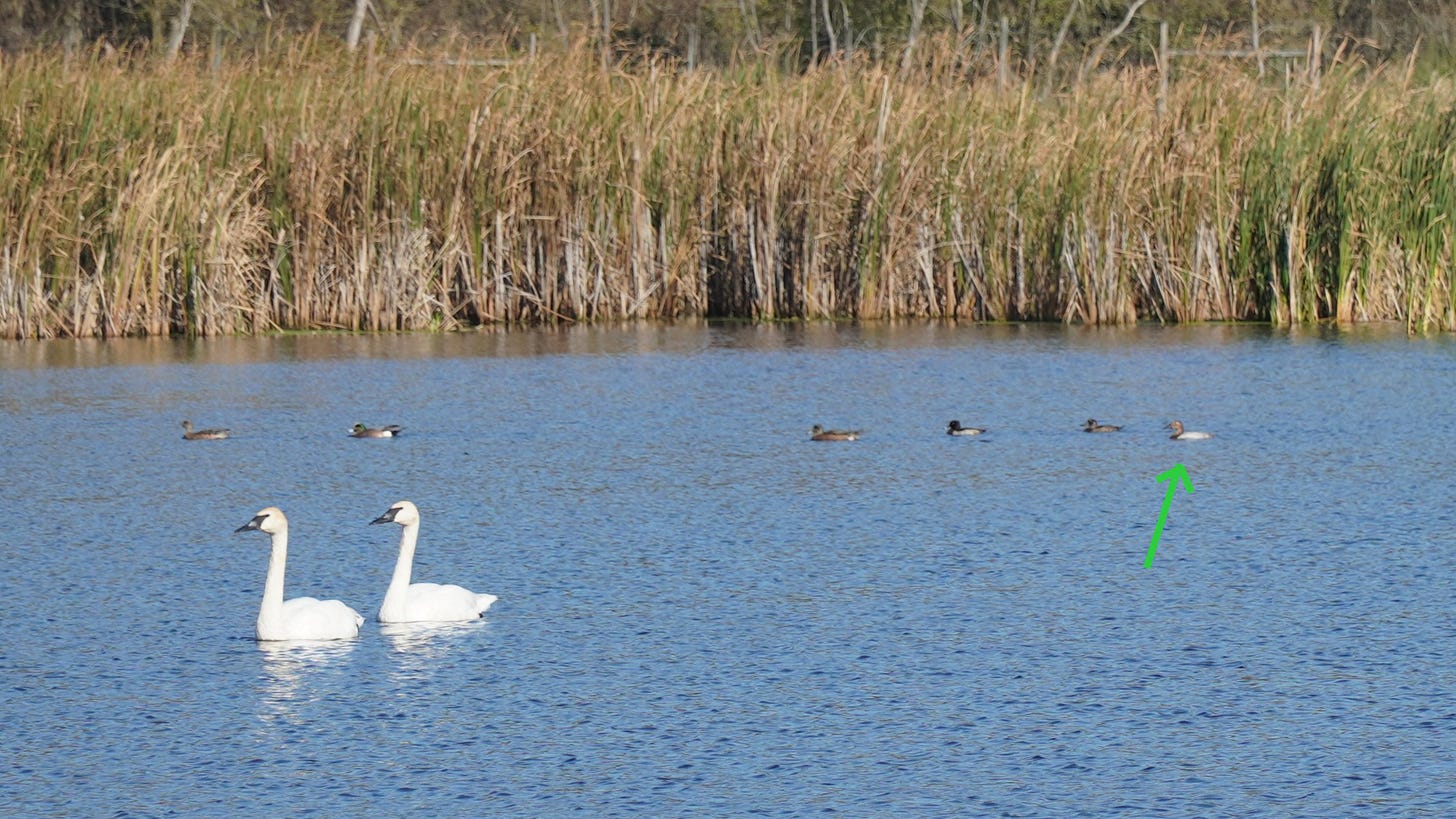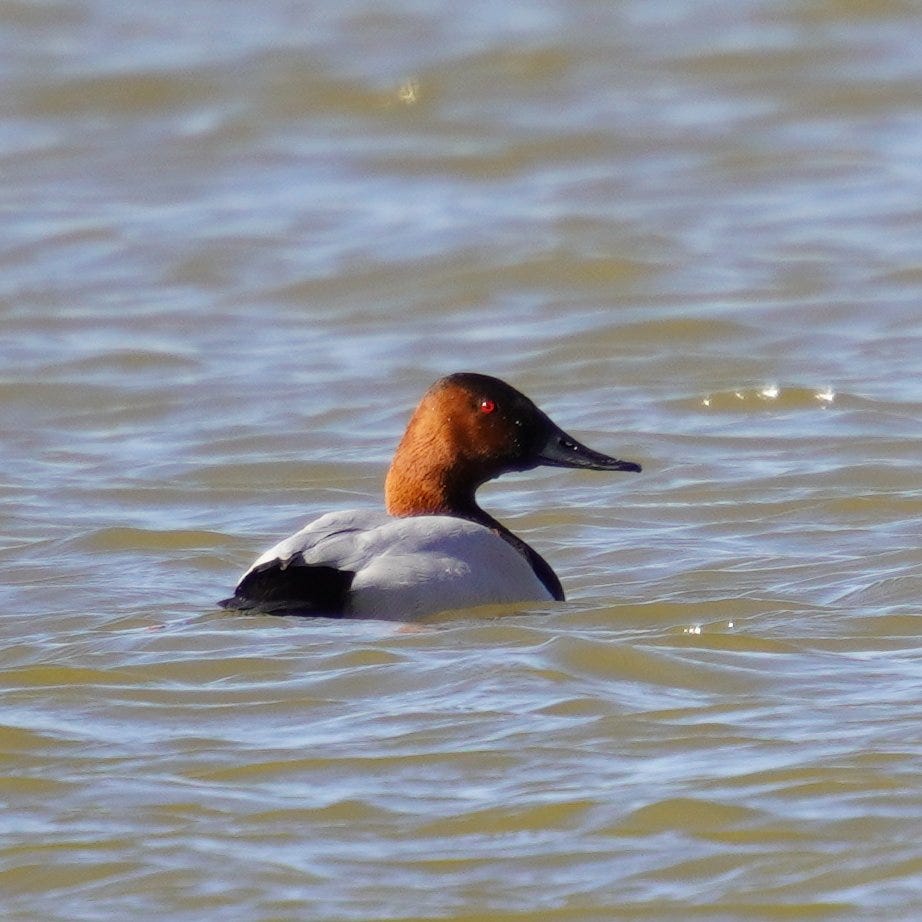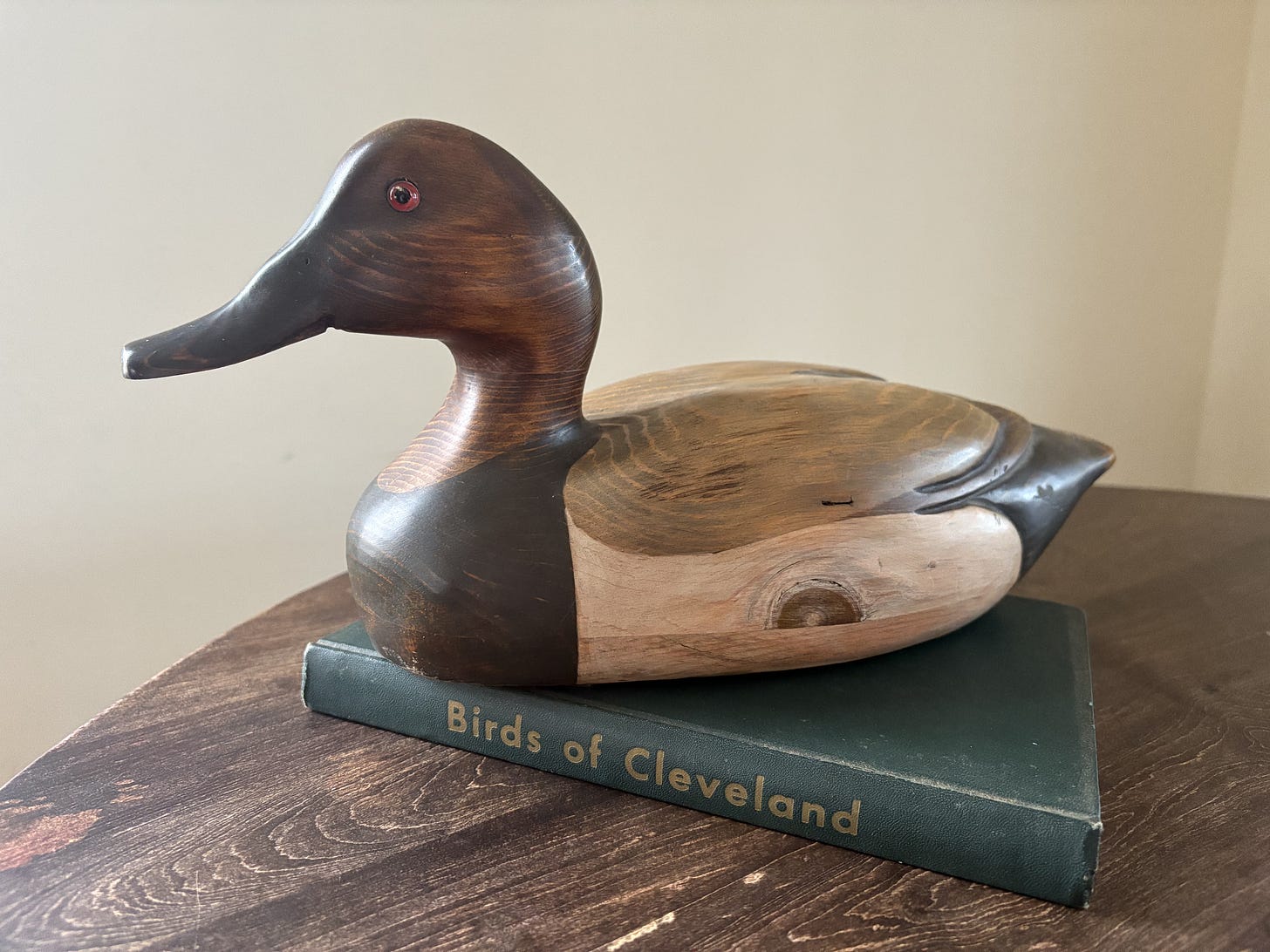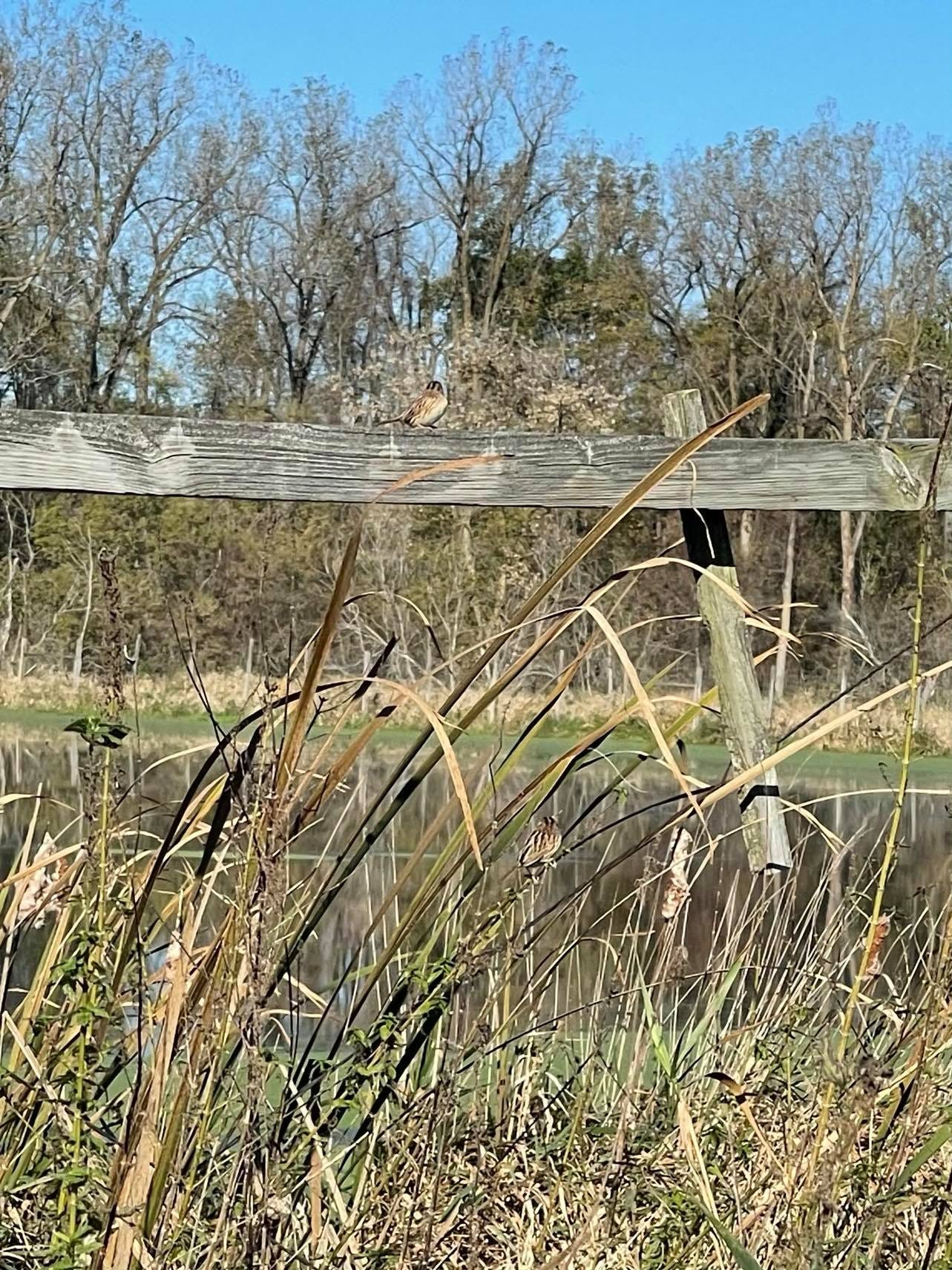The Top Ten, Canvasback Edition
On the Incredible, Apparently Very Edible, Diving Duck
Note: I intended to write a single post for my top ten birds, but each of these wonderful species deserves a full post of its own. These tributes will appear on no set schedule and in no particular order.
The Major League Baseball team located in Cleveland, Ohio did not get in touch with me when the time came to choose a new nickname ahead of the 2022 season. That bothered me. I had some terrific ideas, all bird names, of course. Cleveland Woodcocks I thought a brash and brilliant choice, but one that would never, um, fly. Grebes as a tribute to those criminally undersung diving birds. Nighthawks sounds badass (though I did fear the iconography would depict a raptor and not a nightjar). There were great opportunities for alliteration too. Cleveland Cormorants. Killdeer. Cowbirds.
My favorite idea was Cleveland Canvasbacks. Perfect, right? Catchy. Original. A chance for design and marketing opportunities centered around the world’s most beautiful duck, a bird that can often be seen from the shores of Lake Erie.
Alas, the pleas I vomited across social media went unheeded, and the Cleveland brass settled on the, in my opinion, very lame Guardians. Rest assured—when this Substack has enough paid subscribers that I can buy the team, a major wrong will be made right.
Okay, enough baseball—on to the bird!
I was in a bad mood when I saw my first Canvasback. That was October 19, 2021. As I had several times that month, I drove twenty minutes north to Corey Marsh Ecological Research Center, the Michigan State University property that served as its muck soils research farm for seventy years before being transformed into an inland wetland research site in 2012. Corey Marsh is one of central Michigan’s best birding spots, and when I started birding daily in 2020, it quickly became my main patch in Clinton County.
The woods, fields, ponds, and tall grasses of Corey Marsh make it a haven for birds of all types, including ones that can be tough to find in that part of the state. Marsh Wren, Sora, and Northern Shrike were a few of the lifers I got there. An array of songbirds, waterfowl, shorebirds, and raptors find the confines of Corey Marsh most hospitable. And yet in spite of the diverse avifauna, Corey Marsh was not a heavily frequented site. Often I had the run of the place, and the Trumpeter Swans, Bank Swallows, and Willow Flycatchers all to myself.
That is, until the appearance of a Nelson’s Sparrow that month attracted hoards to the usually sleepy spot. When the Nelson’s was joined by a LeConte’s Sparrow a couple of weeks later, birders arrived in flocks from all around the state and beyond. Yep, Corey Marsh is great for rarities too, and that’s what I was there for—two rare sparrows.
In my inaugural Substack post, I asserted that more birders is good for birds. I believe that’s true—except when it isn’t. Nelson’s and LeConte’s Sparrows are secretive and will hide in the tall grass for seemingly ever. Several out of towners, no doubt determined not to have made a long drive for nothing, took the liberty of going off trail and tramping through the grass, habitat for rails (even Yellow Rails!), gallinules, and other reclusive birds, in order to flush the sparrows.
More birders are good for birds when they care more about protecting the places birds live and breed than they do about getting a photograph.
That reckless behavior shocked me then and still does more than five years later. Yet I’m possibly more pissed that not one of the people who patiently stood there, content to let the birds pop out when they damn well felt like it (myself included), said a word about the destruction we were witnessing.
After it became clear no rare sparrows were forthcoming, I turned toward the ponds to see what migrating ducks might be hanging around. Anything good? I asked a fellow birder who was trekking back from the viewing area. I remember an unenthusiastic response. Judging by my checklist, he probably mentioned the several American Wigeons, Ring-necked Ducks, and Redheads I ended up reporting on eBird. I don’t remember. What I do remember was the And one Canvasback, he tagged on at the end.
Well, the opportunity to get my lifer Canvasback injected my step with ample pep and made me forget all about those trampling nincompoops. This sighting happened before I purchased a spotting scope, but since the ponds at Corey Marsh aren’t very large, my binoculars sufficed.
All it took was one look. One look and I knew. This was the one. The duck. My duck.
This terrible photo does the bird no justice, but the moment was special. I stood there, ogling. Smitten and elated. This was more than a lifer, it was love.
Never had I beheld so handsome a waterfowl, gifted the kind of elegance usually reserved for swans. The graceful, seamless slope of the head into the bill, a bill long enough to rival the Northern Shoveler but without crossing into ridiculousness. The thick, long neck that evoked a Tundra Swan.
I didn’t know then I was looking at an eclipse male (the dull plumage seen in the weeks after breeding). Naturally, my admiration has only grown in subsequent, closer encounters. I mean, check out that eye! Looking not at me but through me. So piercing and fiery-red I felt compelled to conceal any rings I might be carrying.
Then there’s the plumage, gleaming white but with a black front and rear, like a quintuple-stuffed Oreo. But maybe more than anything, it’s the chestnut head.
What is it with me when it comes to chestnut-colored feathers? I’m not sure, and my wife Alex apparently doesn’t get it either. I rhapsodized not long ago about the splashes of chestnut on certain spring warblers—Chestnut-sided, Bay-breasted, Cape May. It’s an beautiful accent, I told her. A perfect complement to warbler yellows and greens. Indeed it was my favorite color in all of birddom, I pronounced in sudden spasm of clarity, to myself, to her, to the world!
So…brown, she deadpanned.
Yes. Brown! And the male Canvasback is all glory with its big, beautiful brown head. The best brown to be found in nature. I don’t think I’ve shut up about Canvasbacks since that October, and apparently my admiration was noted because this one showed up under the Christmas tree one year.
And let’s not forget the females. Understated in color, perhaps, but just as sleek, just as regal, just as worthy of our fawning admiration.
Though they’ve captured my heart, not so my eye. I have yet to take a picture of a Canvasback I’m satisfied with. But I’ll keep trying because this love isn’t fleeting.
Ten CanvasFacts
Speaking of fleeting love, Canvasbacks know a thing or two about that. Instead of mating for life, they’re only seasonally monogamous. Oh, they’ll stick together for a little while, but when the next breeding season comes along and it’s time to get frisky, these ducks see greener grass.
The Canvasback is North America’s largest diving duck. Bigger in this case does mean better.
Canvasbacks love to dive, but they also sometimes dabble, which means they don’t fully submerge but dunk their heads into the water to retrieve sustenance. Picture a Mallard’s eating habits, or a human when there are apples in a barrel or, if you prefer, pies on a table.
Brainy people sometimes refer to the Canvasback as Aythya valisineria. The genus name Aythya can be traced back to the ancient Greek αἴθυιᾰ, or aithuia, which refers to an indeterminate diving duck. The species name is derived from Vallisneria americana, the species of wild celery Canvasbacks love to munch on.
And if you’re dying to know, Vallisneria americana is named for Antonio Vallisneri, the famed 17th century Italian botanist. If there’s anything sexier to be named after, or to have named after you, than a type of aquatic celery, I’d like to hear it.
Though there are some more interesting notions about where its common name comes from, the general consensus around the internet seems to be that the bird’s bright white color reminded early English settlers of canvas, the rugged, and sometimes bright, white fabric.
Over the years, Canvasbacks have also been called Can, King Can, Bullneck, Canard Chevel, Canny, Canvas, Gray Duck, Horse-duck, Red-headed Bullneck, Sheldrake, Whiteback, and, best of all, Hickory-quaker. I’d love to know some indigenous names for the bird but haven’t dug any up yet.
The celery-heavy diet apparently gave Canvasback flesh a flavor so prized among the dining elite at the turn of the 20th century, it was nearly hunted to oblivion. The bird was typically served at the finest establishments with hominy croquettes and a currant sauce. (For more on the Canvasback’s history as a delicacy, read these terrific articles by Robert Francis and Hank Shaw.)
When the Migratory Bird Treaty Act of 1918 outlawed market hunting, the road was paved for the Canvasback’s recovery, sort of. Though it may have disappeared from the menu of the Waldorf Astoria, the bird continued to face pressures in the form of inland wetland habitat loss, pollution, and lead poisoning from spent shot. Protections to critical habitat have helped Canvasbacks rebound, though never to their previous numbers, and populations have fluctuated drastically over the past 70 years. Currently, there are around 700,000 Canvasbacks, compared to fewer than 400,000 in the 1980s.
Largely forgoing the standard duckish quack-quackery, the dignified Canvasback is a mostly silent bird. However, they do make some sounds. Instead of me trying to describe their vocalizations, you can listen to them here.
Featured Photo—LeConte’s Sparrows
I didn’t see the Corey Marsh LeConte’s Sparrow the first couple of times I tried. Then, one early weekday morning, with no one else around, the LeConte’s appeared. Then another one appeared. Then another! I’m never the person who finds a rarity, but I’ll take being the one who finds three of the same rarity a few days later. I only had my phone at the time, but I was able to capture two of the three in one frame. This picture is notable not just for being the worst LeConte’s Sparrow photograph ever taken, but also for being a certified one-star photo on eBird. Enjoy, and feel free to add your own one-star rating!
10/10 Recommends
Bird History, Robert Francis
For my money, no one is writing about bird history in a more engaging and engrossing style than Robert Francis. Meticulously researched and endlessly fascinating, I always come away from Robert’s Substack posts feeling slightly smarter than I did going in. If an 11/10 Recommend were possible, Bird History would get it.
Aside from being an outstanding birding hotspot, Corey Marsh is doing exactly the kind of work that can help the Canvasback along its road recovery—developing ways to mitigate the impacts of agricultural practices and climate change on inland wetlands. And of course it is a wonderful spot to spend a day birding, especially during migration. If you do go, just remember to stay on the ample trails available to the public.
That’s all for this week. Do you have a favorite duck? Tell me which! Have you ever managed a great photo of it? I’d love to see! I’m also currently accepting good, mediocre, bad, and abysmal photos of my (or your) favorite duck.
Until next time, bird your Canvasbackside off!
nwb
If you found this post informative or were in any way entertained, consider supporting my work by becoming a paid subscriber. Baseball teams aren’t going cheap these days. As always, 5% of earnings donated to the American Birding Association.
Or buy me a beer at the ollld balllll-game.
This post was human-generated. All photos by Nathaniel Bowler.









That's a beautiful duck!
Ohh I didn’t even knew this one existed. Will have to add it to my list now, obviously!